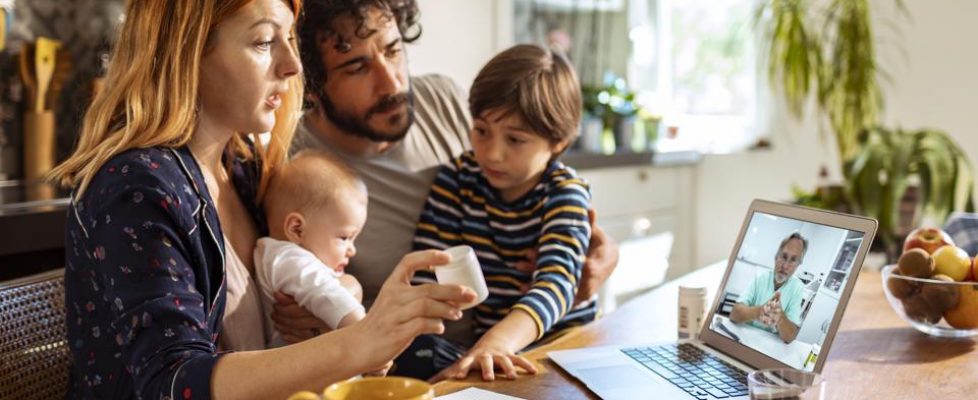Telehealth Works. How Well Depends On A Few Factors
Covid-19 has seen a massive increase in the use of telemedicine. While it may seem novel, it’s actually been around for decades and research shows it’s frequently just as effective as face-to-face interventions, if not better. But how well it works for you mostly depends on your healthcare system.
When it comes to telemedicine, we already know what we’re doing
Telemedicine has been around for decades, but it never really took off in the way you might expect—that is, until now.
“This has been a real-world experiment, if you like,” says health economics and policy expert Nkiru Eze.
“All the barriers that we were facing previously, it’s almost as if they’ve melted away because we’ve had no other option but to access remote care.”
Ms Eze has just published an umbrella review of telemedicine in the OECD, identifying what the state of play was before Covid-19 in terms of clinical and cost-effectiveness, patient experience, and implementation of telehealth.
What her team found was that although not all healthcare can be delivered remotely, telemedicine has mostly been as effective as normal care and, in some cases, better.
Telehealth diabetes management, for example, was reported to have better than or comparable results to face-to-face interventions.
When it came to cardiovascular disease, remote monitoring and phone support were “superior to usual care in reducing the odds of mortality and hospitalization related to heart failure, improve survival rates and reduce cardiovascular disease risk factors such as weight, BMI and blood pressure.”
Telemedicine has helped manage pain effectively and increase exercise levels, improved mental health and diet, and aided in the control of respiratory diseases like asthma.
And, according to studies, people like using it (patients more so than health practitioners), whether it takes the form of mobile apps, remote monitoring, online support, or picking up the phone.
Healthcare is not like other markets
So, if the reviews have been so good, why haven’t we taken it up in greater numbers before now? Other industries have been transformed by remote service provision. Why not primary healthcare?
“If you look at it from a health economics perspective, the healthcare market is different,” says Ms Eze.
“That’s part of the reason why it’s not been implemented at the scale that you think it would be.
“It’s not as easy as saying, for example, because we used to shop in stores before and now online shopping has come, most people are going to move online. Healthcare is not really the same.”
For one thing, it’s generally not discretionary.
“There’s things like inelasticity of demand. If you were sick, you’d literally pay anything to get better. So there are no real alternatives,” explains Ms Eze.
“If you’re on a budget you can either buy butter or vegetable spread, which is cheaper. But in most cases for healthcare there’s not that option for you to choose. And even if there were, you wouldn’t know what drug to choose instead of another. You don’t have all the information.”
Success comes down to the healthcare system where you live
When you look at what’s happened with telehealth around the world, Ms Eze says it’s not about who does it better.
“I wouldn’t use the word ‘better’,” she says.
“It has to do with policy, with the reimbursement models. It’s the way that healthcare systems are set up.”
Canada, for instance, has recently implemented new policies to reimburse doctors for telemedicine.
“Reimbursement was the biggest barrier. Telemedicine takes as much time as face-to-face. Sometimes it could take longer. And time is money. So if you’re not reimbursing for telemedicine there wouldn’t be that much uptake for it, or else doctors are providing healthcare for free,” Ms Eze explains.
She says the fee-for-service model of healthcare provides more of a challenge for telehealth than, say, a salary structure.
“It comes down to your healthcare system and what policies are in place. So if the policy makers want it to work, then you need to give doctors incentive to provide telemedicine.”
And then there are the barriers faced by patients. While technology is cheaper and more advanced than it’s ever been, it still costs a significant amount of money to buy equipment—even just a smart phone, which is often the bare minimum—and pay for internet. People also need access to appropriate training and support.
“The people most likely to benefit are those who are normally marginalized from accessing face-to-face care: people who live in remote areas, people that are disabled, those who are house-bound, some older adults, those who don’t have transport and so on,” says Ms Eze.
But she says these are the people telemedicine is less likely to reach.
“That’s who interventions should be targeted to when everything normalizes. It’s a bit of a paradox. Telemedicine is more likely to reach those who are tech savvy and who live in urban areas.”
It’s equitable now and cost-effective in the long term
Ms Eze explains that providing telehealth to rural areas, for instance, may not appear cost-effective in the short term, but will provide a long-term economic benefit.
“You’re averting a worsening of their condition,” she says. “If you look at the long-term horizon, it’s potentially cost-effective when you look at the hospitalizations that you’re going to avoid by intervening early.
“You will reap the benefits in 10 or 20 years’ time.
“And it’s like any other intervention. [You have to] to put those cost controls measures in place to make sure the costs don’t spiral out of control.”
Ms Eze believes telehealth is here to stay.
“I know a lot of healthcare systems are looking at their reimbursement models again and thinking about how we can deliver care remotely. And I think it will be the future, definitely.”
“But I don’t have a glass ball,” she laughs. “So, I don’t know.”

